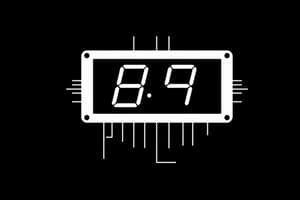Podcast
Questions and Answers
What does Figure(2) illustrate about shift registers?
What does Figure(2) illustrate about shift registers?
- Types of clock pulses
- Control signals in shift registers
- Types of data movement (correct)
- Size of shift registers
How many basic types of shift registers are mentioned in the text?
How many basic types of shift registers are mentioned in the text?
- Five
- Four (correct)
- Three
- Two
In a Serial in-Serial out shift register, how is data accepted?
In a Serial in-Serial out shift register, how is data accepted?
- Serially, one bit at a time on a single line (correct)
- In parallel, multiple bits at a time on multiple lines
- Only at the output stage
- Randomly, with no specific order
What happens when the first clock pulse is applied in a Serial in-Serial out shift register?
What happens when the first clock pulse is applied in a Serial in-Serial out shift register?
How many bits of data can a 4-stage serial in-serial out shift register store?
How many bits of data can a 4-stage serial in-serial out shift register store?
What does Figure(3) depict in relation to shift registers?
What does Figure(3) depict in relation to shift registers?
What is the primary purpose of a shift register?
What is the primary purpose of a shift register?
How is data stored in a shift register?
How is data stored in a shift register?
What determines the storage capacity of a shift register?
What determines the storage capacity of a shift register?
How is data moved within a shift register?
How is data moved within a shift register?
What distinguishes a register from a counter?
What distinguishes a register from a counter?
What is the primary function of a flip-flop in a shift register?
What is the primary function of a flip-flop in a shift register?
What enables each data bit to be applied to the D input of its respective flip-flop?
What enables each data bit to be applied to the D input of its respective flip-flop?
What happens when a clock pulse is applied to the flip-flops in this circuit?
What happens when a clock pulse is applied to the flip-flops in this circuit?
What is the sequence of bits shifted into the register in the example?
What is the sequence of bits shifted into the register in the example?
Which gates enable the data bits to shift right from one stage to the next in this circuit?
Which gates enable the data bits to shift right from one stage to the next in this circuit?
How many clock pulses are required to completely shift the bits out of the register?
How many clock pulses are required to completely shift the bits out of the register?
What function do the OR gates serve in this shift register circuit?
What function do the OR gates serve in this shift register circuit?
What happens to the bits in the register during the shifting out process?
What happens to the bits in the register during the shifting out process?
Why does FF0 have a single AND to disable the parallel input D0?
Why does FF0 have a single AND to disable the parallel input D0?
Which flip-flop output does the data get shifted out from?
Which flip-flop output does the data get shifted out from?
What is the purpose of the shift register in this context?
What is the purpose of the shift register in this context?
What gets loaded into the register on clock pulse 1 according to the provided text?
What gets loaded into the register on clock pulse 1 according to the provided text?
What is the significance of the clock pulses in the operation of the shift register?
What is the significance of the clock pulses in the operation of the shift register?
What is the purpose of the ̅̅̅̅̅̅̅̅̅ input in the 74HC165 shift register?
What is the purpose of the ̅̅̅̅̅̅̅̅̅ input in the 74HC165 shift register?
How are the flip-flops in the 74HC165 set and reset during parallel loading?
How are the flip-flops in the 74HC165 set and reset during parallel loading?
What is the function of the CLK INH input in the 74HC165?
What is the function of the CLK INH input in the 74HC165?
How are the serial data outputs of the 74HC165 represented?
How are the serial data outputs of the 74HC165 represented?
What is the difference between the 74HC165 and the synchronous parallel loading method discussed earlier?
What is the difference between the 74HC165 and the synchronous parallel loading method discussed earlier?
Based on the given information, what is the purpose of the SER input in the 74HC165?
Based on the given information, what is the purpose of the SER input in the 74HC165?
Flashcards are hidden until you start studying





